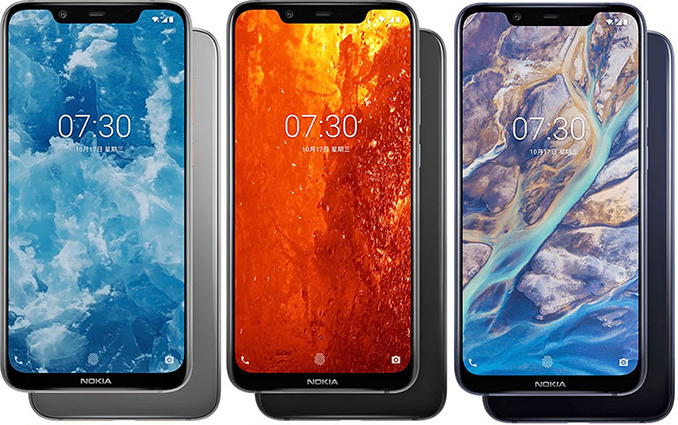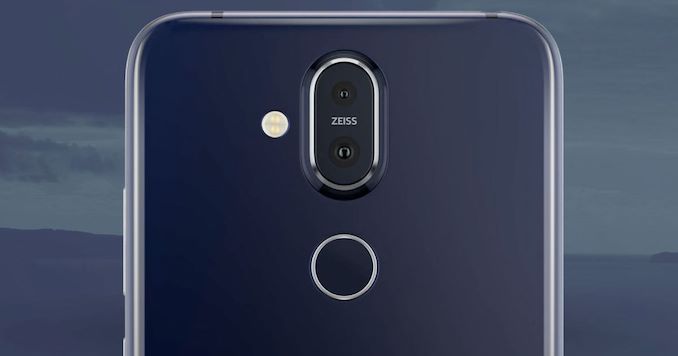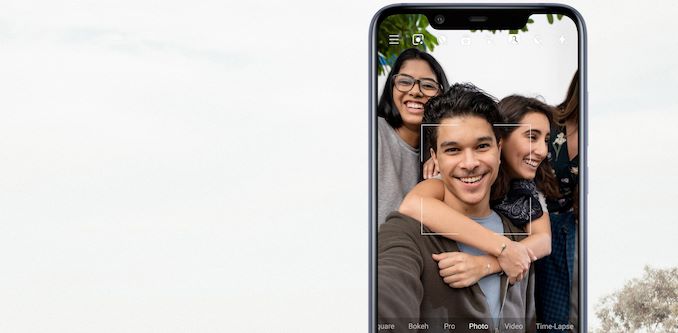Nokia 8.1 Unveiled: Elegant Phone with 6.18-Inch Display, 20MP Selfie Cam, Zeiss Optics
by Anton Shilov on December 11, 2018 2:00 PM EST- Posted in
- Smartphones
- Nokia
- Android
- HMD Global
- Nokia 8

HMD Global has introduced its new flagship smartphone, the Nokia 8.1. The phone features a large 6.18-inch display, an elegant design with a metallic frame, an advanced camera with Zeiss optics, and a pretty unique selfie camera with a 20 MP sensor. What sets the Nokia 8.1 apart from other Nokia 8-branded devices released by HMD so far is an odd choice of SoC and features for a high-end smartphone. In fact, the Nokia 8.1 looks to be a rebadged version of the Nokia X7 introduced in China earlier this year.
Positioning, Chassis and Display
Let us start from the positioning of the phone. Nokia’s 8-series has traditionally been all about style (as discussed in historical flashback of our Nokia 8 Sirocco coverage), yet they did feature many differentiating innovations, essentially being Nokia’s business-oriented 6-series in a more premium chassis with a very distinctive design.
Officially, HMD positions the Nokia 8.1 between the Nokia 8 released in Fall 2017 and the Nokia 8 Sirocco launched last Spring, leaving the Nokia 8 Sirocco on the very top of HMD’s product range. Meanwhile, many features of the new Nokia 8.1 make it more of a successor to the Nokia 7 Plus rather than the Nokia 8.
The Nokia 8.1 comes with regular Gorilla Glass front with an aluminum frame chassis. By contrast, the Nokia 8 and the Nokia 8 Sirocco used a aluminum unibody with a and a Gorilla Glass 5 front, along with a stainless steel frame. The new phone is slightly larger than other Nokia 8-branded devices, but it also features the largest display with as well includes a notch. As for colour options, the new Nokia 8.1 will be available in Blue/Silver, Steel/Copper, and Iron/Steel colors.
Moving on to the display. The Nokia 8.1 comes with a 6.18-inch IPS display featuring a 2280x1080 resolution with an 18.7:9 aspect ratio, resulting in a pixel density of 408 PPI. HMD says that the screen features its PureDisplay hardware and software tech powered by a PixelWorks chip that supports HDR10, can upscale SDR content to HDR, adjusting brightness and contrast dynamically to ensure optimal visual experience both indoors and outdoors. Nokia introduced its PureDisplay technology in October along with its Nokia 7.1 smartphone, and while formally the display is not as advanced as the POLED screen used on the Nokia 8 Sirocco, does have the benefit of HDR10 playback, which will help video media playback.
A Look Inside
When it comes to internals, the Nokia 8.1 is based on Qualcomm’s new Snapdragon 710 processor accompanied by 4 GB of LPDDR4X DRAM and 64 GB of eMMC 5.1 NAND flash storage. The choice of SoC is pretty logical for a performance-mainstream Nokia X7, but the chip looks a bit odd in a Nokia 8-branded device (which have used Qualcomm’s Snapdragon 835). In the meantime, Snapdragon 710 integrates eight Kryo 360 cores (two semi-custom Cortex-A75 and six Cortex-A55 cores in DynamIQ configuration), the Adreno 616 GPU, and the X15 LTE modem (800/150 Mbps UL/DL).
As for the battery, the Nokia 8.1 handset is outfitted with a 3500-mAh battery, one of the highest capacity batteries in a modern Nokia smartphone, and comes witth 18 W fast charging support. The phone will ship with Android 9 Pie as the OS, which has a number of battery life-oriented optimizations. The combination of the bigger battery as well as newer generation SoC allows HMD/Nokia to proclaim that the new handset will work for a longer time on one charge when compared to predecessors.
| General Specifications of the Nokia 8.1 | ||
| Nokia 8.1 | ||
| Display | Size | 6.18" |
| Resolution | 2280×1080 (18.7:9) | |
| PPI | 408 PPI | |
| Cover | Gorilla Glass | |
| Processor | PixelWorks | |
| SoC | Snapdragon 710 8 × Kryo 360 @ 1.7 - 2.2 GHz 2x semi-custom Cortex-A75 cores 6x semi-custom Cortex-A55 cores |
|
| GPU | Adreno 616 | |
| RAM | 4 GB LPDDR4X | |
| Storage | 64 GB + microSD | |
| Networks | GSM GPRS (2G), UMTS HSPA (3G), LTE (4G) | |
| SIM Size | Nano SIM | |
| SIM Options | Dual SIM, second SIM slot is used by microSD card | |
| Local Connectivity | 802.11ac Wi-Fi, BT 5.0, 3.5mm jack, USB 2.0 Type-C |
|
| Front Camera | 20 MP | |
| Rear Camera | Main: 12 MP, f/1.8, 1.4µm, Dual Pixel PDAF Depth: 13 MP, f/2.0, 0.9µm Flash: dual-LED |
|
| Battery | 3,500 mAh | |
| Dimensions | Height | 154.8 mm | 6.09 inches |
| Width | 75.8 mm | 2.98 inches | |
| Thickness | 8 mm | 0.31 inches | |
| Weight | 180 grams | 6.35 ounces | |
| Launch OS | Android 9.0 Pie | |
Cameras & Interfaces
Imaging capabilities are among the key selling features of Nokia’s smartphones, so the X7/8.1 come equipped with rather advanced cameras. The main camera traditionally uses optics co-designed with Zeiss and comprises of a 12MP sensor with an f/1.8 aperture, a 13MP B&W sensor to capture depth, and a dual-tone flash. The selfie camera features a 20MP f/2.0 sensor and support “AI-enhanced” face unlock, a major improvement when compared to the Nokia 8 Sirocco.
As always, Nokia’s camera software features numerous enhancements and exclusive features, including a Pro Camera Mode that enables a thorough control of white balance, ISO, aperture, and shutter speed, as well as the “bothie” mode that enables to record videos or take photos using both front and back cameras simultaneously.
Moving on to essential interfaces that the Nokia 8.1 has. On the wireless side of things there are obviously 802.11ac Wi-Fi, Bluetooth 5.0, and GPS/AGPS+GLONASS+Beidou positioning. On the physical side of things, the handset has a USB 2.0 Type-C connector for charging and data, a 3.5-mm TRRS audio jack, a speaker, and a microphone.
Price & Availability
HMD plans to start sales of the Nokia 8.1 globally starting from December 15 – December 21 timeframe depending on the country. The recommended pricing of the smartphone is €399 for Europe, which is considerably below roughly €550 for the Nokia 8 Sirocco. It is unknown how much the phone will cost in the US and when HMD plans to make it available in North America, though it is reasonable to expect the handset to show up on this side of Atlantic in the coming weeks.
Meanwhile, the Nokia X7 is already available in China for the price of roughly $307 - $380 for the regular 4GB/64GB model and for $370 - $440 for the premium version outfitted with 6 GB of RAM and 128 GB of storage.
Related Reading:
















15 Comments
View All Comments
Strafeb - Tuesday, December 11, 2018 - link
You have an error. S710 has 2xA75 and 6xA55 based cores.evilspoons - Tuesday, December 11, 2018 - link
I'm curious if they'll move in to Canada any time soon. The LTE bands required for a few of the carriers are different than the European/Chinese models, and importing from the USA is not particularly cheap.PeachNCream - Tuesday, December 11, 2018 - link
You could move to the US. We could use nice, sane people from the outside world anyway.heffeque - Wednesday, December 12, 2018 - link
Why would he want to move to a country with no universal health care? Doesn't seem intelligent.FSWKU - Tuesday, December 11, 2018 - link
• Massive, battery-sucking screen• 3500mAh battery for said screen
• Another damn notch
• A higher resolution selfie-cam than the main camera
This thing is a joke, right? At least it still has a 3.5mm jack and they didn't add 50 cameras.
PeachNCream - Tuesday, December 11, 2018 - link
I know right? I'm not even sure its actually a sales trend for buyers to constantly chase larger screens or if thats just what the manufacturers think people want because people are buying them since the OEMs are not offering decent hardware beneath smaller screens. Also, the camera specs are rather stupid. I'd rather not have a very high quality front facing camera anyhow. No one needs to be able to see highly detailed face shots of peoples' icky pores and scalp flakes.piroroadkill - Wednesday, December 12, 2018 - link
You summed it all up. Yawn. next.Mr Perfect - Wednesday, December 12, 2018 - link
That's an awfully wide notch, too. It looks like there's room for only one notification icon between the clock and the notch, every other notification will be hidden away in the overflow menu.kreacher - Tuesday, December 11, 2018 - link
This one is also using EMMC instead of UFS as per the Nokia India site.Isn't that like a PC with an old HDD instead of SSD.
Codadomo - Tuesday, December 11, 2018 - link
The 8.1 (4/64) is already on sale in Taiwan for US$333.The main difference from the X7 is the inclusion of NFC, which is kinda important for stuff like Google Pay.